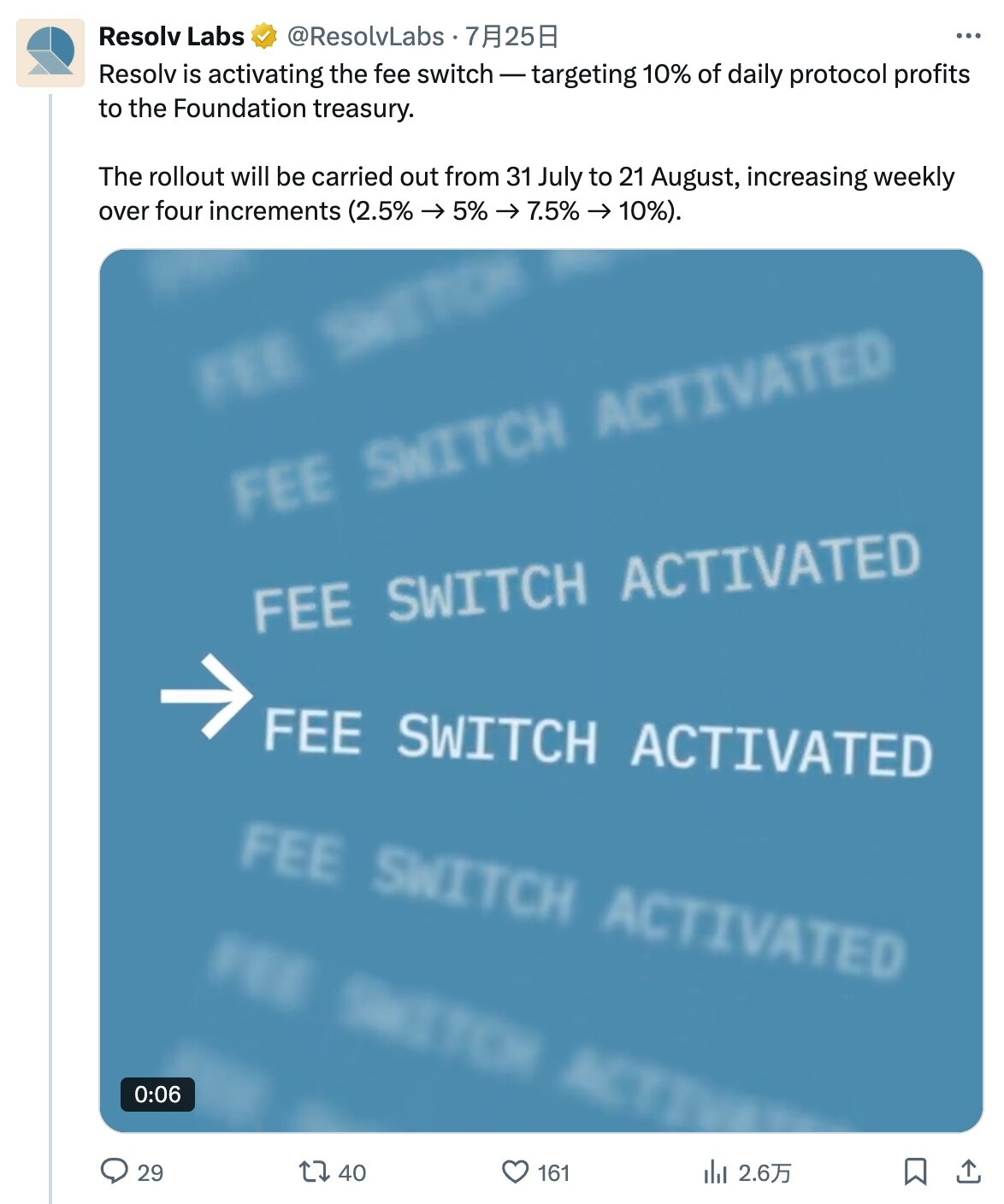With the “fee switch” activated, will RESOLV become the next ENA?
- 核心观点:Resolv 启动“费用开关”以激励代币质押。
- 关键要素:
- 逐步转移 10% 协议收入至金库。
- 年化收益率达 9.5%,表现优异。
- 静态估值性价比优于竞品 ENA。
- 市场影响:短期提振 RESOLV 币价,但长期存疑。
- 时效性标注:短期影响。
Original | Odaily Planet Daily ( @OdailyChina )
Author|Azuma ( @azuma_eth )

On July 25, Beijing time, the interest-bearing stablecoin protocol Resolv officially announced that it will gradually turn on the "fee switch" and plans to transfer up to 10% of the daily protocol income to the foundation treasury for the long-term value creation of the protocol and to incentivize RESOLV staking users. Specifically, Resolv plans to gradually increase the income transfer ratio (2.5% → 5% → 7.5% → 10%) every week during the four-week period from July 31 to August 21, and finally reach the target value of 10%.

The so-called "fee switch" is a common term for fee allocation in DeFi protocols. Its popular understanding is "a built-in contract function that determines whether the protocol allocates revenue to native tokens", but different protocols have different specific execution modes. Previously, well-known projects such as Uniswap and Ethena have also discussed the "fee switch" issue, but failed to activate it due to community allocation disputes and concerns about the maturity of conditions.
Generally speaking, the "fee switch" generally means a direct benefit to the protocol's native token, because this will directly amplify the token's value capture ability; but on the other hand, since the "fee switch" often transfers part of the income that originally belonged to the protocol users to the token holders, it will damage the interests of users to a certain extent, so the major protocols are always hesitant about whether to turn on the "fee switch" - for example, in the Uniswap scenario, the original liquidity provider (LP) can obtain all 0.3% of the transaction fee income, but after the "fee switch" is turned on, it has to transfer part of the income to UNI holders, and the interests of LP will be relatively damaged.
Resolv's Positioning and Considerations
Back to Resolv, similar to Ethena's USDe, the USR issued by Resolv is also an interest-bearing stablecoin collateralized by equal amounts of spot longs and contract shorts. Its income mainly comes from "the staking income of spot longs" and "the funding rate income of contract shorts."
However, compared to Ethena, Resolv has also made some additional mechanism designs, such as introducing a risk grading mechanism through the insurance pool RLP, which enables USR to achieve a higher excess collateral rate; another example is the access to a larger proportion of liquidity derivative tokens, which achieves higher spot staking returns. Under Resolv's mechanism design, the protocol has achieved an annualized rate of return of about 9.5% since its inception, which is quite outstanding among a number of emerging stablecoins.
At the end of May, Resolv officially launched the governance token RESOLV. Although Resolv has tried to empower RESOLV by "providing high staking returns" and "accelerating the accumulation rate of points for the second season airdrop", the performance of RESOLV after its launch is still not ideal. Perhaps it is precisely to boost the price of the coin that Resolv has set its sights on the "fee switch".
In the official announcement about turning on the “fee switch”, Resolv mentioned that “the timing and architecture are now ripe” - the protocol has achieved real, non-theoretical traction; the protocol has a clear value distribution framework; the protocol has demonstrated resilience - therefore it was decided not to postpone the launch of the “fee switch”.

As mentioned above, Resolv plans to gradually increase the income transfer ratio over four weeks, and will eventually increase it to 10%. As for the specific use of this part of the income, Resolv stated that it will be used to "expand the value that Resolv provides to users and stakers" , including: 1) Supporting new integrations between DeFi, Fintech, and institutional venues; 2) Funding ecosystem grants and product development; 3) Promoting buybacks and other token-related initiatives. Resolv also mentioned that a dedicated dashboard will be launched in the future to track the use of income.
Resolv also made a rough assumption about the distribution of protocol revenue after the "fee switch" is turned on. Based on the current protocol's TVL of $500 million and an average rate of return of 10%, it is expected to achieve $50 million in revenue per year. After the "fee switch" is turned on, $45 million will still flow directly to users through product revenue, and the protocol will retain $5 million for long-term value creation.
Compared to ENA, is RESOLV more cost-effective?
In last week’s article “ Up nearly 50% in a week, will ENA be the biggest Beta of ETH? ”, we analyzed the logic behind ENA’s recent strong rise; afterwards, Ethena launched a treasury reserve mechanism similar to “micro-strategy” around ENA, further boosting the price of ENA.
With the early launch of ENA, more and more people have begun to turn their attention to Resolv, an interest-bearing stablecoin project with a similar mechanism. So, is RESOLV really more cost-effective than ENA?
From the static figures, the current TVL of Ethena is US$7.781 billion, the ENA circulating market value (MC) is US$4.016 billion (MC/TVL ratio is 0.51), and the full circulation valuation (FDV) is US$9.48 billion (FDV/TVL ratio is 1.22); the current TVL of Resolv is US$527 million, the RESOLV circulating market value (MC) is US$57.28 million (MC/TVL ratio is 0.108), and the full circulation valuation (FDV) is US$205 million (FDV/TVL ratio is 0.39).
Judging from the comparison of MC/TVL and FDV/TVL alone, RESOLV is indeed better than ENA in terms of static cost performance. Although ENA is currently supported by the treasury reserve strategy, considering that RESOLV will be the first to open the "fee switch", the currency prices of both parties are expected to be supported in the short term.
However, objectively speaking, the current application scope and network effect of USR are far less than that of USDe. In addition, in addition to USDe, Ethena also has a second business line USDtb. From the perspective of protocol potential, Resolv still has a large gap compared to Ethena.
Another point worth noting is that Resolv’s statement on the “fee switch” revenue mentioned above is that “will be used to expand the value that Resolv provides to users and stakers”, but it did not mention how much of the 10% revenue will flow to RESOLV stakers, so it is difficult to speculate on the scale of additional value capture by RESOLV after the “fee switch” is turned on.
In general, considering that RESOLV's market value is at a relatively low level, the current RESOLV is a great alternative option after ENA surges, but the long-term development prospects of the Resolv protocol itself are still to be evaluated, and the detailed income distribution plan after the "fee switch" is turned on is yet to be disclosed. Whether it is worth building a position, you still need to DYOR.



